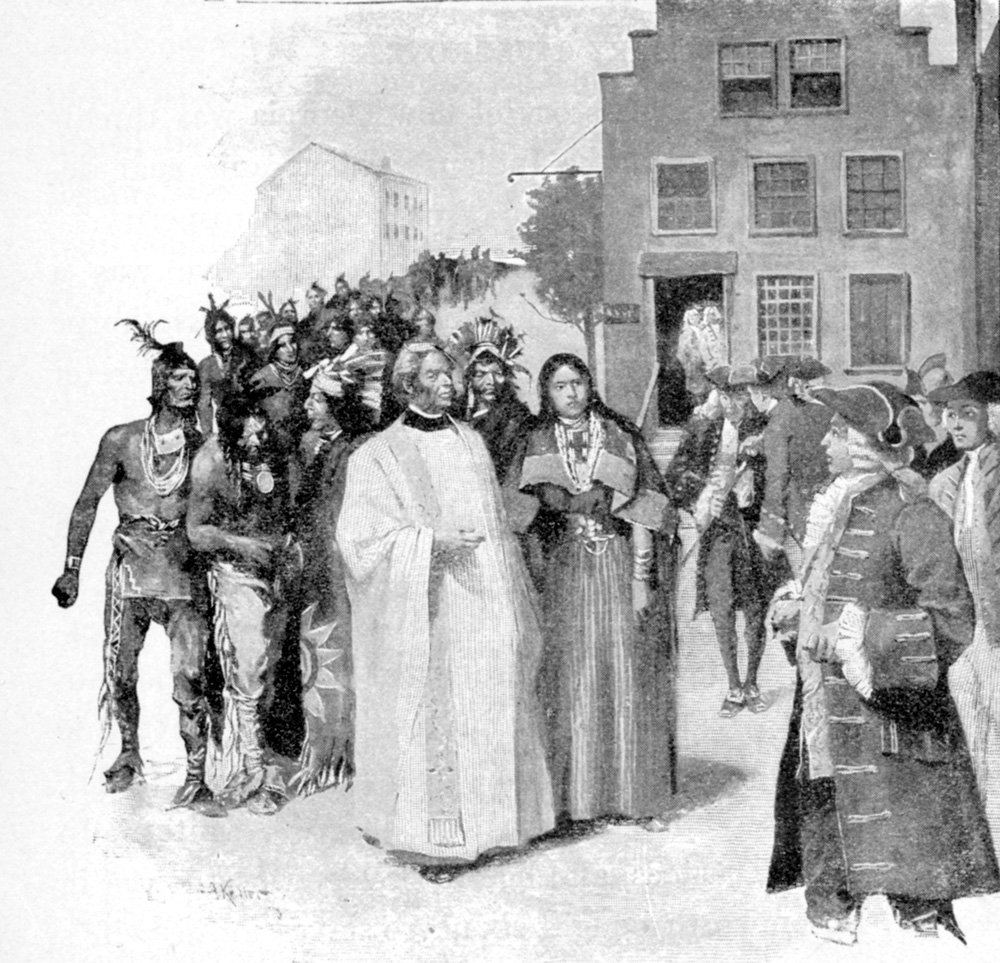
Mary Musgrove and her husband Reverend Bosomworth supported by 200 Muscogee Natives in Savannah. National Women’s History Museum.
Coosaponakeesa, better known by her English name, Mary Musgrove, was born around the year 1700 to an English father and a Muscogee (“Creek”) mother in the tribal town of Coweta near where Columbus, Georgia, is today. Her brother was Chief of Coweta, and she was related to two prominent Muscogee leaders, Brims and Chigelli. Her mother made sure she learned the Muscogee language and traditions including about the deerskin trade, and her father took her to Pon Pon in South Carolina where she learned English and eventually married an English trader, like her father, named John Musgrove in 1717. Coosaponakeesa was considered a full member of her tribe, as the Muscogee people were a matrilineal society.
Coosaponakeesa and her husband set up a trading post along the Savannah River where she worked as an interpreter. Her skill as an interpreter eventually caught the eye of General James Oglethorpe, a charter member of Georgia. Impressed with her skills in interpreting, Oglethorpe hired Coosaponakeesa to be his primary interpreter in 1733, a position she would hold for over a decade. Together, Coosaponakeesa and John made quite a name for themselves, even being sent gifts from the King of England and receiving a 500-acre land grant in Georgia. Unfortunately, just two years after entering her position for Oglethorpe, Coosaponakeesa’s husband became ill and passed away leaving a large amount of land in both South Carolina and Georgia. Coosaponakeesa moved the trading post to Yamacraw Bluff in Georgia. However, Georgia law only allowed her to maintain control of the land until her son would be of age to own it. This proved to be a problem for Coosaponakeesa, who had lost all three of her children during their infancy.
Perhaps as a way to save the land, Coosaponakeesa married her Englishman indentured servant, Jacob Mathews in 1737. Together they set up a new trading post in Mount Venture on the Altamaha River. While working for Oglethorpe and running her trading post with her second husband, she continued interpreting. Her interpreter skills coupled with her business acumen helped maintain peaceful and fair trade relations between the Georgia Colony and the Muscogee Nation. She even successfully negotiated relations between the Yamacraw Chief, Tomochichi, and the Savannah settlers. However, tragedy once again struck Coosaponakeesa in 1742, when her husband Mathews passed away.
Two years after her second husband’s passing, Coosaponakeesa would marry her third and final husband, Reverend Thomas Bosomworth, a missionary. The marriage brought with it an elevation in status that no one of Muscogee blood had been given previously. In fact, the rise was so unexpected, many Colonists did not believe the marriage was real at first. Coosaponakeesa, who had previously married men from what many saw as the lower branches of society, had become part of the upper echelon of colonial society. Together the couple would take messages from Oglethorpe and the King in England to the Muscogee Nation and return with speeches from Muscogee leaders. They also taught missionaries the Muscogee language.
Despite her prominence and all that she did for Colonist and Muscogee relations, Coosaponakeesa could never outrun her troubles with land ownership. Even after marrying Bosomworth, the issue of land granted to her by the Yamacraw Chief years prior continued. The issue of land became even more complicated when the “Lower Creek” Chief Malatchi granted Coosaponakeesa and Bosomworth three of the Sea Islands: Ossabaw, Sapelo, and St. Catherines. The issue was that British officials refused the claims to the land stating that a nation can only cede or grant land to another nation, not an individual.
The fight for the lands lasted over a decade. At one point in 1749, Coosaponakeesa even had more than 200 Muscogee accompany her to the Savannah courthouse in support of her claim. When the courts continued to refuse to accept her grant, she traveled to England in hopes of pleading her case. In 1754 the Board of Trade heard her case, but they ultimately referred the case back to the Georgia Courts. By the time she returned to Georgia, however, the disputed lands had come under Georgia control. It was not until 1760 that a compromise was reached between Coosaponakeesa and then Royal Governor Henry Ellis. Coosaponakeesa would get to keep St. Catherines Island and be given £2,100 in exchange for giving up her claim to the other two islands.
Coosaponakeesa would ultimately pass away a few years later, around 1763, on St. Catherines Island. She continued to serve as a mediator between Georgia and the Muscogee people until her death. In 1993, Coosaponakeesa received some of the recognition she deserved when she was inducted into Georgia Women of Achievement for her contribution to the state including helping negotiate the settlement of Savannah which would ultimately lead to the founding of Georgia as a colony.
References
Alexander, K. L. (2019). Mary Musgrove. National Women’s History Museum. https://www.womenshistory.org/education-resources/biographies/mary-musgrove
Coon, D. (2014, March 14). Time travel: Mary Musgrove proves powerful partner. Savannah Morning News. https://www.savannahnow.com/story/lifestyle/columns/2014/03/15/time-travel-mary-musgrove-proves-powerful-partner/13554196007/
Frank, A. K. (2002). Mary Musgrove. In New Georgia Encyclopedia. https://www.georgiaencyclopedia.org/articles/history-archaeology/mary-musgrove-ca-1700-ca-1763/
National Park Service (n.d.) The Muscogee creek. Department of the Interior. https://www.nps.gov/liri/learn/historyculture/the-muscogee-creek-1600-1840.htm